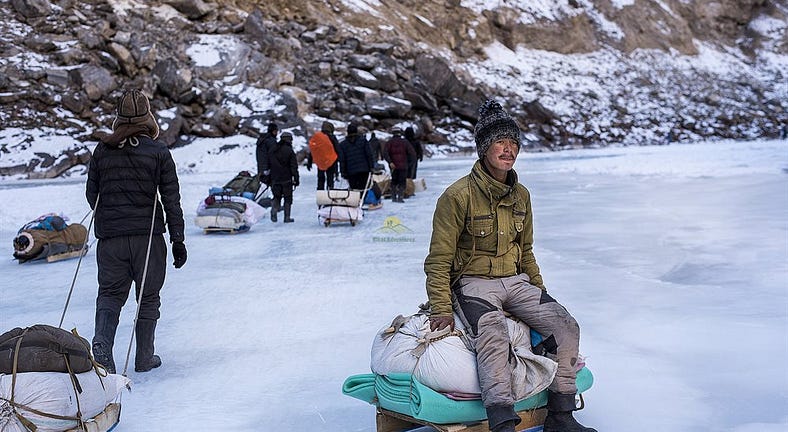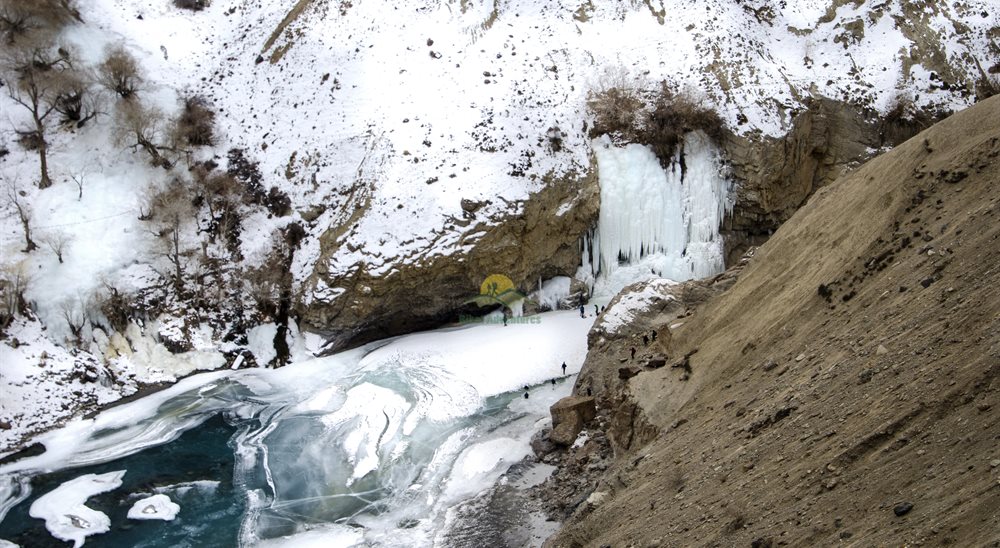The Chadar Trek is one of the most unique and thrilling winter treks in the world, taking adventurers on a journey across the frozen Zanskar River in Ladakh, India. Known for its breathtaking landscapes, challenging conditions, and cultural richness, the Chadar Trek offers an experience like no other. This guide will provide you with everything you need to know to conquer the Chadar Trek, from preparation to the best times to visit and tips for a successful adventure.
1. What is the Chadar Trek?
The Chadar Trek, also known as the “Frozen River Trek,” involves trekking across the frozen Zanskar River in the heart of the Himalayas. This trek is typically done in the winter months of January and February when temperatures plummet, and the river freezes over, forming a thick sheet of ice known as the “Chadar,” or blanket. The trek covers approximately 105 kilometers over 8–9 days, with temperatures ranging from -10°C to -30°C, making it one of the most challenging treks in India.
2. The Unique Experience of Walking on Ice
Walking on a frozen river is a surreal experience that can only be described as walking on water. The ice on the Zanskar River varies in thickness and texture, requiring trekkers to be vigilant and adaptable. Sometimes, the ice is thick and solid, while at other times, it can be thin and crack underfoot, forcing trekkers to walk along the edges or navigate tricky patches. The trek offers stunning views of towering cliffs, frozen waterfalls, and serene landscapes, providing a glimpse into a world few have seen.

3. Preparing for the Chadar Trek
Physical Fitness: The Chadar Trek is physically demanding due to the harsh weather conditions and challenging terrain. Trekkers should be in good physical shape, with strong stamina and endurance. Preparations should include cardio exercises, strength training, and long walks to build up stamina.
Mental Preparation: Mental toughness is equally important for this trek. The extreme cold, long days of walking, and potentially dangerous conditions require a positive attitude and resilience.
Essential Gear and Clothing: Proper gear is crucial for the Chadar Trek. Layered clothing is key, including thermal innerwear, fleece jackets, waterproof outerwear, insulated gloves, woolen socks, and sturdy trekking boots. Additional items such as trekking poles, crampons, a headlamp, a sleeping bag rated for sub-zero temperatures, and a backpack are also essential.
4. Best Time to Experience the Chadar Trek
The best time to undertake the Chadar Trek is from mid-January to mid-February when the ice on the Zanskar River is at its thickest. During this period, the weather is cold but stable, and the ice conditions are optimal for trekking. However, trekkers should be prepared for sudden changes in weather and temperatures that can drop drastically.
5. The Route and Itinerary
Day 1: Arrival in Leh
Acclimatization is crucial for this trek. Spend a day or two in Leh to adjust to the high altitude (11,500 feet). Take short walks, stay hydrated, and avoid strenuous activities.
Day 2: Medical Check-Up and Preparation
Before embarking on the trek, a mandatory medical check-up is conducted to ensure trekkers are fit for the journey. Gather your gear and meet your guide for a briefing on the trek.
Day 3: Leh to Tilat Sumdo (Drive and Trek)
The trek begins with a drive from Leh to Chilling, followed by a short trek to Tilat Sumdo. This is the first experience of walking on the frozen river, and trekkers get a feel for the ice.

Day 4: Tilat Sumdo to Shingra Koma
A full day of trekking on the Chadar begins, covering around 10 kilometers. The trek passes through narrow gorges and stunning frozen landscapes.
Day 5: Shingra Koma to Tibb Cave
Continue trekking along the frozen river to Tibb Cave, a natural shelter used by trekkers and locals. This stretch offers views of frozen waterfalls and dramatic ice formations.
Day 6: Tibb Cave to Naerak
This is one of the most scenic parts of the trek, leading to Naerak village. Trekkers will encounter a massive frozen waterfall and can interact with the local Zanskari villagers.
Day 7: Naerak to Tibb Cave
The return journey begins, retracing the steps back to Tibb Cave. The landscape looks different on the way back, and trekkers must be cautious of changing ice conditions.
Day 8: Tibb Cave to Shingra Koma
Continue trekking back towards Shingra Koma, enjoying the serene beauty of the frozen river and towering cliffs.
Day 9: Shingra Koma to Tilat Sumdo and Drive to Leh
The final day of trekking brings you back to Tilat Sumdo, followed by a drive back to Leh, where you can rest and celebrate your successful trek.
6. Challenges and Safety Considerations
Extreme Cold: Temperatures can drop to as low as -30°C, and the wind chill can make it feel even colder. Proper clothing and gear are essential to avoid frostbite and hypothermia.
Altitude Sickness: The Chadar Trek takes place at high altitudes, and altitude sickness is a risk. Acclimatization, staying hydrated, and recognizing early symptoms are crucial.
Ice Conditions: The ice on the Zanskar River can be unpredictable. Trekkers must be prepared for varying ice conditions, including cracks, thin patches, and sections with running water.
Health and Safety Precautions: It is important to have a guide and follow their instructions. Carry a basic first aid kit, including medication for altitude sickness, cold-related ailments, and any personal medication.
7. Cultural Immersion in Zanskar Valley
The Chadar Trek not only offers a unique adventure but also a chance to immerse yourself in the culture of the Zanskar Valley. The Zanskaris are warm and hospitable, and trekkers have the opportunity to learn about their way of life, traditions, and challenges of living in such a remote region. Visiting local villages and interacting with the villagers provide insight into their resilience and close connection with nature.

8. Tips for a Successful Chadar Trek
- Hire a Reputable Trekking Company: Choose a company with experienced guides and good safety records.
- Travel in Groups: Trekking in groups adds safety and companionship.
- Stay Hydrated and Eat Well: Drink plenty of fluids and consume high-energy foods to maintain energy levels.
- Respect Nature: Follow the principles of “Leave No Trace.” Keep the environment clean and respect local customs and wildlife.
- Stay Informed: Keep up-to-date with weather conditions and any changes in the ice conditions.
9. Why the Chadar Trek is a Must-Do
The Chadar Trek is a once-in-a-lifetime experience that challenges both body and mind. It offers a unique opportunity to explore a frozen landscape, interact with a vibrant culture, and test your limits in one of the most remote and beautiful regions of India. For those seeking adventure, solitude, and a deep connection with nature, the Chadar Trek is an unforgettable journey.

10. Conclusion
Conquering the Chadar Trek is no small feat, but for those who dare to take on this frozen river adventure, the rewards are immense. The trek offers not just physical challenges but also a profound sense of accomplishment and an opportunity to witness the breathtaking beauty of the Himalayas in its rawest form. Whether you are an experienced trekker or someone looking to push your boundaries, the Chadar Trek is a journey that will leave you with memories to last a lifetime.
Embark on this extraordinary adventure, and let the frozen Zanskar River guide you through one of the most incredible experiences of your life.






Comments